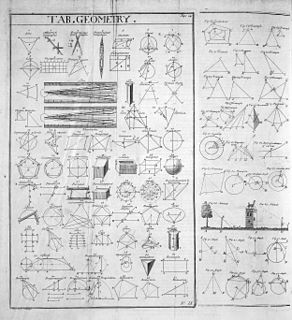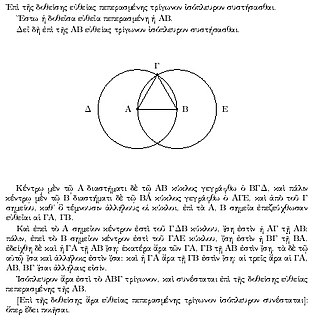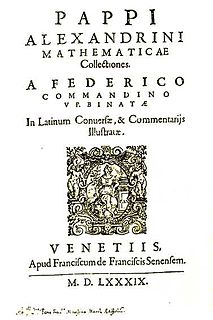
Euclid, sometimes called Euclid of Alexandria to distinguish him from Euclid of Megara, was a Greek mathematician, often referred to as the "founder of geometry" or the "father of geometry". He was active in Alexandria during the reign of Ptolemy I. His Elements is one of the most influential works in the history of mathematics, serving as the main textbook for teaching mathematics from the time of its publication until the late 19th or early 20th century. In the Elements, Euclid deduced the theorems of what is now called Euclidean geometry from a small set of axioms. Euclid also wrote works on perspective, conic sections, spherical geometry, number theory, and mathematical rigour.

Geometry arose as the field of knowledge dealing with spatial relationships. Geometry was one of the two fields of pre-modern mathematics, the other being the study of numbers (arithmetic).

The area of study known as the history of mathematics is primarily an investigation into the origin of discoveries in mathematics and, to a lesser extent, an investigation into the mathematical methods and notation of the past. Before the modern age and the worldwide spread of knowledge, written examples of new mathematical developments have come to light only in a few locales. From 3000 BC the Mesopotamian states of Sumer, Akkad and Assyria, together with Ancient Egypt and Ebla began using arithmetic, algebra and geometry for purposes of taxation, commerce, trade and also in the field of astronomy and to formulate calendars and record time.

Straightedge and compass construction, also known as ruler-and-compass construction or classical construction, is the construction of lengths, angles, and other geometric figures using only an idealized ruler and compass.

In mathematics, a curve is, generally speaking, an object similar to a line but that need not be straight. Thus, a curve is a generalization of a line, in that its curvature need not be zero.

Angle trisection is a classical problem of compass and straightedge constructions of ancient Greek mathematics. It concerns construction of an angle equal to one third of a given arbitrary angle, using only two tools: an unmarked straightedge and a compass.

In geometry, the Dandelin spheres are one or two spheres that are tangent both to a plane and to a cone that intersects the plane. The intersection of the cone and the plane is a conic section, and the point at which either sphere touches the plane is a focus of the conic section, so the Dandelin spheres are also sometimes called focal spheres.
Diocles was a Greek mathematician and geometer.
Menaechmus was an ancient Greek mathematician and geometer born in Alopeconnesus in the Thracian Chersonese, who was known for his friendship with the renowned philosopher Plato and for his apparent discovery of conic sections and his solution to the then-long-standing problem of doubling the cube using the parabola and hyperbola.
Dinostratus was a Greek mathematician and geometer, and the brother of Menaechmus. He is known for using the quadratrix to solve the problem of squaring the circle.

The neusis is a geometric construction method that was used in antiquity by Greek mathematicians.
Hypsicles was an ancient Greek mathematician and astronomer known for authoring On Ascensions (Ἀναφορικός) and the Book XIV of Euclid's Elements. Hypsicles lived in Alexandria.
Serenus of Antinoupolis was a Greek mathematician of the Roman Imperial Period.
Carpus of Antioch was an ancient Greek mathematician. It is not certain when he lived; he may have lived any time between the 2nd century BC and the 2nd century AD. He wrote on mechanics, astronomy, and geometry. Proclus quotes from an Astronomical Treatise by Carpus concerning whether problems should come before theorems, in which Carpus may have been criticising Geminus. Proclus also quotes the view of Carpus that "an angle is a quantity, namely a distance between the lines of surfaces containing it." According to Pappus, Carpus made use of mathematics for practical applications. According to Iamblichus, Carpus also constructed a curve for the purpose of squaring the circle, which he calls a curve generated by a double motion.
On Spirals is a treatise by Archimedes, written around 225 BC. Although Archimedes did not discover the Archimedean spiral, he employed it in this book to square the circle and trisect an angle.
A timeline of algebra and geometry

The quadratrix or trisectrix of Hippias is a curve, which is created by a uniform motion. It is one of the oldest examples for a kinematic curve, that is a curve created through motion. Its discovery is attributed to the Greek sophist Hippias of Elis, who used it around 420 BC in an attempt to solve the angle trisection problem. Later around 350 BC Dinostratus used it in an attempt to solve the problem of squaring the circle.





















